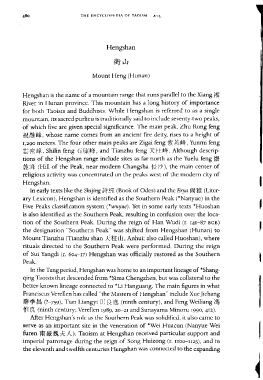Page 520 - The Encyclopedia of Taoism v1_A-L
P. 520
THE ENCYCLOPEDIA OF TAOISM A-L
Hengshan
Mount Heng (Hunan)
Hengshan is the name of a mountain range that runs parallel to the Xiang lfll
River in Hunan province. This mountain has a long history of importance
for both Taoists and Buddhists. While Hengshan is referred to as a single
mountain, its sacred purlieu is traditionally said to include seventy-two peaks,
of which five are given special significance. The main peak, Zhu Rong feng
f5LW\~~, whose name comes from an ancient fire deity, rises to a height of
1,290 meters. The four other main peaks are Zigai feng ~ ;;;;: wf, Yunmi feng
~~: W w~, Shilin feng {i ~ wit, and Tianzhu feng -x. f l: wlf. Although descrip-
tions of the Hengshan range include sites as far north as the Yuelu feng ~
11't2 w~ (Hill of the Peak, near modern Changsha K 11}'), the main center of
religious activity was concentrated on the peaks west of the modern city of
I
Hengshan.
In early texts like the Shijing ~H:1I (Book of Odes) and the Erya 1l!HfE (liter-
ary Lexicon), Hengshan is identified as the Southern Peak (*Nanyue) in the
Five Peaks classification system (*wuyue). Yet in some early texts *Huoshan
is also identified as the Southern Peak, resulting in confusion over the loca-
tion of the Southern Peak. During the reign of Han Wudi (r. 141-87 BCE)
the designation "Southern Peak" was shifted from Hengshan (Hunan) to
Mount Tianzhu (Tianzhu shan -x. U ill , Anhui; also called Huoshan), where
rituals directed to the Southern Peak were performed. During the reign
of Sui Yangdi (r. 604-17) Hengshan was officially restored as the Southern
Peak.
In the Tang period, Hengshan was home to an important lineage of *Shang-
qing Taoists that descended from *Sima Chengzhen, but was collateral to the
better-known lineage connected to *Li Hanguang. The main figures in what
Franciscus Verellen has called "the Masters of Hengshan" include Xue Jichang
G¥* {§ (?-7S9), Tian Liangyi B-1 L~ ~ (ninth century), and Feng Weiliang {,\§
tf£ B:!. (ninth century; Verellen 1989, 20-21 and Sunayama Minoru 1990, 412).
After Hengshan's role as the Southern Peak was solidified, it also came to
serve as an important site in the veneration of *Wei Huacun (Nanyue Wei
furen m ~ ~ x A). Taoism at Hengshan received particular support and
imperial patronage during the reign of Song Huizong (r. IIOO-II2S), and in
the eleventh and twelfth centuries Hengshan was connected to the expanding

